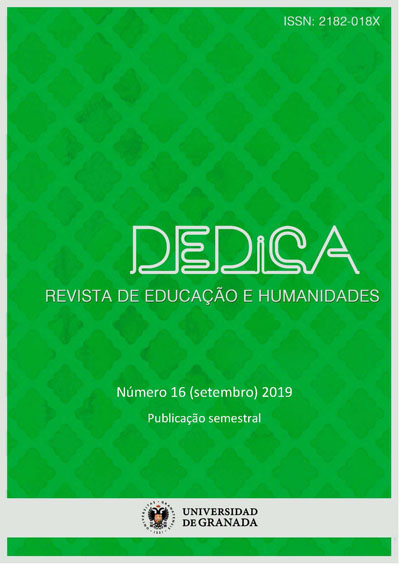Debussy y Monet en el concierto "La danza de los colores". Intervención interdisciplinar de Música y Pintura. Grado en Bellas Artes
DOI:
https://doi.org/10.30827/dreh.v0i16.8462Palavras-chave:
arte, educación, innovación, música, pintura, sinestesiaResumo
Romper la dinámica habitual del aula para mejorar el rendimiento de los estudiantes e incentivar su espíritu de aprendizaje y su creatividad nos lleva a aceptar retos para generar un aprendizaje significativo. En este artículo abordamos una experiencia multisensorial que se organizó junto al Conservatorio Profesional de Música de Teruel (España). Las artes visuales colaboraban como invitadas en el concierto homenaje al pianista y compositor Claude Debussy (en el centenario de su muerte) y para ello se diseñó una intervención mural.
La asignatura de Color I, del área de pintura, trabajó el proyecto a partir del repertorio seleccionado, tomando como punto de partida la sinestesia, que nos servía de puente entre ambas formas de expresión y creación artística. De esta forma, música y pintura se conjugaban en una obra conjunta dentro de un proyecto colaborativo que se construía simultáneamente.
En nuestra propuesta elegimos a Claude Monet, a sus pinturas de nenúfares, para recrear un estanque en cuatro paneles murales que serían pintados in situ por los estudiantes del primer curso.
Al trabajar de forma conjunta se proyectó un trabajo colaborativo atendiendo a la percepción sensorial, a la destreza técnica, y como punto de unión entre ambas disciplinas, los colores y los sonidos que invitaban a sentir y percibir tonos, brillo y armonía en una actividad de innovación.
La intervención mural y la transformación del espacio permitieron que las notas de color y el sonido danzasen dentro de una misma melodía, metáfora de un paisaje sensorial creado sobre el escenario.
Downloads
Referências
AAVV. (2011). Didáctica de las Bellas Artes y la cultura visual, Madrid: Akal.
Acaso, M. (2009). La educación artística no son manualidades. Nuevas prácticas en la enseñanza de las artes y la cultura visual. Madrid: Los Libros de la Catarata.
Acaso, M. (2013). rEDUvolución. Hacer la revolución en la educación. Barcelona: Paidós.
Elder, M. (2014). Conversaciones en Giverny con Claude Monet. Almería: Ediciones Confluencias.
García Collazos, J., & Martínez Samper, C. (2016). “MUDAR LA PIEL_Intervención efímera”. DEDiCA. REVISTA DE EDUCAÇAO E HUMANIDADES, 9 (2016), 45-54.
Larraz, N. (2013). Desarrollo de la creatividad artística en la educación secundaria. Journal for Educators, Teachers and Trainers, 5(1), 151-161.
Marchan Fiz, S. (1987). La estética en la cultura. Madrid: Alianza Forma.
Repollés, J. (2011). Genealogías del arte contemporáneo. Madrid: Akal - Bellas Artes.
Winnero, E.; Goldstein, T.; Vincent-Lancrin, S. (2014). Resultados de la creatividad de la educación artística. En ¿El arte por el arte? La influencia de la educación artística (pp. 173-184). México: OCDE.
Disponible en: https://www.oecd-ilibrary.org/education/el-arte-por-el-arte_9789264224902-es












